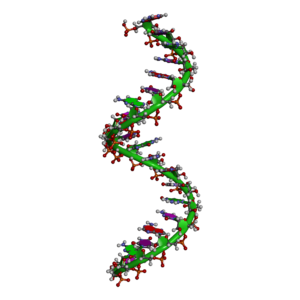RNA
Contents
hideExplanation
RNA or Ribonucleic acid is the molecule found in the cell nucleus of life forms on Earth, which helps decode and transcribe the genetic information from the DNA to the ribosomes to form proteins. There are different types of RNAs in the cell like the mRNA, tRNA, rRNA and each has different functions in the protein synthesis process.
Just like the DNA molecule, RNA is made up of three smaller chemical compounds, a sugar molecule, a phosphate molecule, and four types of nitrogen containing bases. These three compounds together are called as nucleotides of the RNA. The nucleotides are bonded together in short polymeric chains. RNAs are unstable when compared to DNAs as the RNA has a ribose sugar molecule, which has a hydroxyl group, which makes hydrolysis of RNA possible.
Frequently Asked Questions
How are the nitrogenous bonded?
In RNA the nitrogenous bases are bonds with each other with a hydrogen bond. RNA generally forms with one of the strands of the DNA molecule as a template. But the order in which they bond is AUGC, where A is adenine, U is uracil, G is guanine, and C is cytosine. In DNA thymine (T) is found instead of uracil.
Why RNA has uracil instead of thymine?
Uracil undergoes methylation to form thymine. So it requires more energy to produce thymine from uracil, and this is one of the reasons RNAs don't have thymine. RNAs are not as stable as DNA and are produced in a larger number. Hence the energy efficient model would be to have uracil and not to methylate to thymine. Another way to look at this is why DNA has thymine and not uracil. In DNA, cytosine undergoes deamination to form uracil. The deamination of cytosine results in the mutation of the DNA and is often repaired in the DNA with the help of Uracil-DNA glycosylase. So if DNA had uracil instead of thymine, the repairing process would not be able to identify the mutation correctly. In RNAs, the mutations are short lived, and it doesn't cause any effects in the cell. And hence the configuration works by nature.
Why is RNA single-stranded?
The presence of a hydroxyl group in the RNA nucleotide results in the formation of a single stranded structure. Although the single stranded structure is the common occurrence in RNAs, a few viruses have double stranded RNAs too. Also, for a successful coding of genes as a part of its gene expression functions from the DNA, an RNA complement should form with one of the DNA strands. For such functions, the single stranded structure is the energy efficient way for an RNA.

